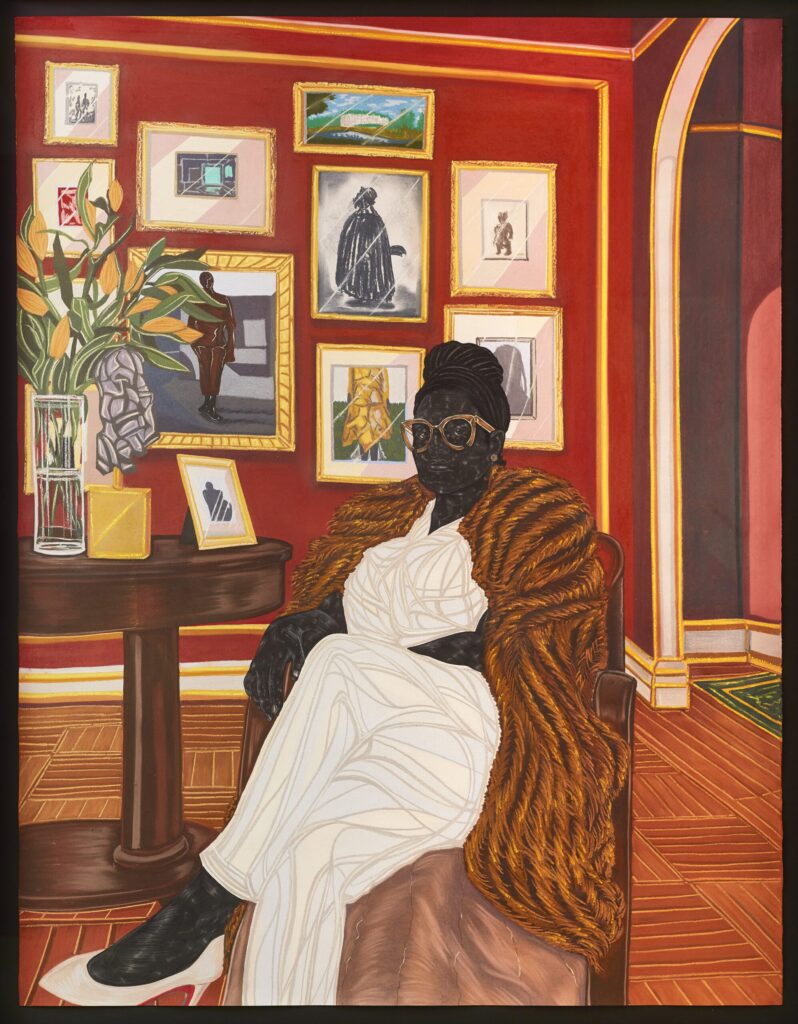The Marchioness (work of art)
Información sobre la obra de arte
Key Ideas
- This work depicts a character from a fictional aristocratic Nigerian family that the artist created. The subject’s clothing and the decor in her surroundings represent her wealth and status.
- A marchioness is someone who holds the rank of nobility of marquess, or is the wife of a marquess.
- Toyin Ojih Odutola is a Nigerian-American artist. She is known for her distinctive mark-making style, particularly in her depiction of skin.
- Ojih Odutola uses foreshortening to play with perspective in this work. This technique makes the seated figure look nearly life-sized to the viewer.
- Ojih Odutola uses her work to explore themes of identity and traveling or transporting the self.
Más información
Toyin Ojih Odutola is a Nigerian-American contemporary artist. She was born in Nigeria and moved to the United States with her family as a child. She first lived in Berkeley, California, and later moved to Huntsville, Alabama. She went to art school in San Francisco and now resides in New York City. According to Ojih Odutola, growing up in conservative Alabama influenced her work.
I went from being just this Nigerian kid in Berkeley to being a black kid in Alabama. You start to realize, “Oh, I’m flattened. I’m not a whole person anymore.”
My identity is not based on performance, it’s based on something that’s predetermined by someone else, and I don’t even understand what that is because I’m an African who came to America.
Suddenly I’m African-American and black when I didn’t even know what the hell that meant.
Toyin Ojih Odutola
Ojih Odutola is known for her distinctive mark-making style. She uses layered marks to replicate the luminosity of skin. She only uses basic drawing materials, such as ballpoint pens, pencils, pastels and charcoal. Her work rethinks traditional portraiture by using it as a method for visual storytelling. She uses her work to explore themes of identity and transporting the self.
How we cover our bodies and arrange them in space is part of how we communicate identity.
Toyin Ojih Odutola
Ojih Odutola’s book The UmuEze Amara Clan and the House of Obafemi is an illustrated story about two fictional aristocratic Nigerian families, the UmuEze Amara Clan and the House of Obafemi. The book features artworks from her ongoing body of work, which depicts figures from the two fictional families. The artist creates a fictional world in which British colonial rule and transatlantic slavery did not happen. In this world the family lines of Nigerian aristocracy were not disrupted. The figure in The Marchioness is a fictional character created by the artist for this body of work. She is a member of the UmuEze Amara Clan. The title of the work, The Marchioness, refers to her social status. A marchioness is someone who holds the rank of nobility of marquess, or is the wife of a marquess. The fine clothing she wears and her surroundings are used to show her wealth and status. The figure in the work is foreshortened, sitting forward in a way that makes her appear nearly life-sized to the viewer while presiding over the room in which she sits.
Recursos adicionales
Recursos para los profesores
- Read an interview with Toyin Ojih Odutola.
- Read a biography on Ojih Odutola.
- Watch a video interview to hear Ojih Odutola discuss her work.
Recursos para los estudiantes
- Watch a video of Ojih Odutola on connecting with others through portraiture.
- View more works by Ojih Adutola.
- Watch a video of Ojih Audtola narrating a walk-through of her exhibition A Countervailing Theory.
Imágenes
-

The Marchioness
A mixed-media drawing of a dark skin-toned woman sitting in a chair, in a room with parquet flooring. The woman is wearing a white jumpsuit and white heels, with a medium-brown, long fur coat draped over her shoulders. She is wearing glasses, and her black hair is in an updo hairstyle. She is sitting in a wooden chair beside a matching wooden table. A vase of green and light-orange flowers is displayed on the left side of the table. To the right of the flowers is a gold-and-gray sculpture. To the right of the sculpture is a gold picture frame. Behind the woman is a red wall with gold picture moulding. There are 11 artworks in gold frames of varying sizes hanging on the wall. An arched doorway is behind the seated woman, to the right.
